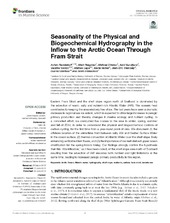| dc.contributor.author | Randelhoff, Achim | |
| dc.contributor.author | Reigstad, Marit | |
| dc.contributor.author | Chierici, Melissa | |
| dc.contributor.author | Sundfjord, Arild | |
| dc.contributor.author | Ivanov, Vladimir | |
| dc.contributor.author | Cape, Matthias | |
| dc.contributor.author | Vernet, Maria | |
| dc.contributor.author | Tremblay, Jean-Éric | |
| dc.contributor.author | Bratbak, Gunnar | |
| dc.contributor.author | Kristiansen, Svein | |
| dc.date.accessioned | 2019-04-29T09:19:01Z | |
| dc.date.available | 2019-04-29T09:19:01Z | |
| dc.date.issued | 2018-06-29 | |
| dc.Published | Randelhoff A, Reigstad M, Chierici M, Sundfjord A, Ivanov V, Cape M, Vernet M, Tremblay J, Bratbak G, Kristiansen S. Seasonality of the Physical and Biogeochemical Hydrography in the Inflow to the Arctic Ocean Through Fram Strait. Frontiers in Marine Science. 2018;5:224 | eng |
| dc.identifier.issn | 2296-7745 | en_US |
| dc.identifier.uri | http://hdl.handle.net/1956/19427 | |
| dc.description.abstract | Eastern Fram Strait and the shelf slope region north of Svalbard is dominated by the advection of warm, salty and nutrient-rich Atlantic Water (AW). This oceanic heat contributes to keeping the area relatively free of ice. The last years have seen a dramatic decrease in regional sea ice extent, which is expected to drive large increases in pelagic primary production and thereby changes in marine ecology and nutrient cycling. In a concerted effort, we conducted five cruises to the area in winter, spring, summer and fall of 2014, in order to understand the physical and biogeochemical controls of carbon cycling, for the first time from a year-round point of view. We document (1) the offshore location of the wintertime front between salty AW and fresher Surface Water in the ocean surface, (2) thermal convection of Atlantic Water over the shelf slope, likely enhancing vertical nutrient fluxes, and (3) the importance of ice melt derived upper ocean stratification for the spring bloom timing. Our findings strongly confirm the hypothesis that this “Atlantification,” as it has been called, of the shelf slope area north of Svalbard resulting from the advection of AW alleviates both nutrient and light limitations at the same time, leading to increased pelagic primary productivity in this region. | en_US |
| dc.language.iso | eng | eng |
| dc.publisher | Frontiers | en_US |
| dc.rights | Attribution CC BY | eng |
| dc.rights.uri | http://creativecommons.org/licenses/by/4.0 | eng |
| dc.subject | Arctic ocean | eng |
| dc.subject | Atlantic water | eng |
| dc.subject | Hydrography | eng |
| dc.subject | Shelf slope | eng |
| dc.subject | nutrients | eng |
| dc.subject | carbon | eng |
| dc.subject | fram strait | eng |
| dc.subject | Barents Sea | eng |
| dc.title | Seasonality of the Physical and Biogeochemical Hydrography in the Inflow to the Arctic Ocean Through Fram Strait | en_US |
| dc.type | Peer reviewed | |
| dc.type | Journal article | |
| dc.date.updated | 2018-07-06T09:36:15Z | |
| dc.description.version | publishedVersion | en_US |
| dc.rights.holder | Copyright 2018 The Author(s) | en_US |
| dc.identifier.doi | https://doi.org/10.3389/fmars.2018.00224 | |
| dc.identifier.cristin | 1595574 | |
| dc.source.journal | Frontiers in Marine Science | |
| dc.relation.project | Norges forskningsråd: 225956 | |
| dc.relation.project | Norges forskningsråd: 226415 | |

